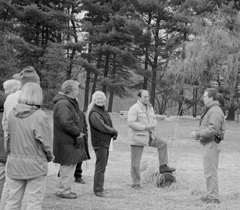The University Record, September 27, 1999 By Inger Schultz
Nichols Arboretum

The appointment of Bob Grese as director of Nichols Arboretum was announced by Provost Nancy Cantor Sept. 17.
“I am delighted to announce the appointment of Bob Grese as director of the Nichols Arboretum. He is known internationally for his scholarship on the history of architectural design and theory, and in the management of natural and cultural landscapes.
“Professor Grese has been closely involved for many years in a wide range of research and educational activities in the Arb, and is deeply engaged with public outreach programs. He is experienced in and committed to developing networks that involve partnerships between the University and local community, industry and government groups to develop ecologically and socially responsible land use policies and practices,” Cantor added.
Grese envisions future partnerships with such groups as the Natural Areas Preservation Program and the City Forestry Department, as well as various departments in the University. “Part of the wonderful thing about the Arboretum is that it can provide the setting for so many kinds of activities— both natural history-related and for art, music and drama events—while retaining its essential character as a place for personal reflection and enjoyment of nature,” Grese said.
Grese, whose appointment is effective Nov. 1, succeeds Harrison L. Morton, current director of the Arb and associate dean of the School of Natural Resources and Environment.
Cantor expressed the University’s “gratitude to Harry Morton for 13 years of outstanding leadership as director of the Arboretum.”
Reflecting community interest in the Arb, the Friends of Nichols Arboretum was established during Morton’s tenure as director. In addition, he supported student involvement through research projects, graduate student caretaker positions and volunteerism. He also supported his academic colleagues by providing the Arb as a resource and field site for more than 40 University classes, from art to engineering to natural resources. In June, the James D. Reader Jr. Urban Environmental Education Center at the Burnham House opened to provide a place for school children and the community to gather and learn before exploring the Arb.
Grese welcomes the opportunity to build on the legacy of the previous directors. “I was delighted to be considered for the directorship. After being
involved with the Arboretum for so long, it has become a very special place for me. Becoming director will be a natural extension of some of the things I’ve already been doing and an opportunity to address some of the Arboretum’s major challenges for the future.
“As we near the centennial of the founding of the Arboretum, it is essential we respect the integrity of the landscape and establish an endowment to ensure its future.”
Nichols Arboretum is a 123-acre living museum at the eastern edge of Central Campus. The historic landscape, designed by O. C. Simonds in 1906, celebrates the dramatic topography and emphasizes the long views framed by the Arb’s collection of Michigan native plants and plants from around the world.

